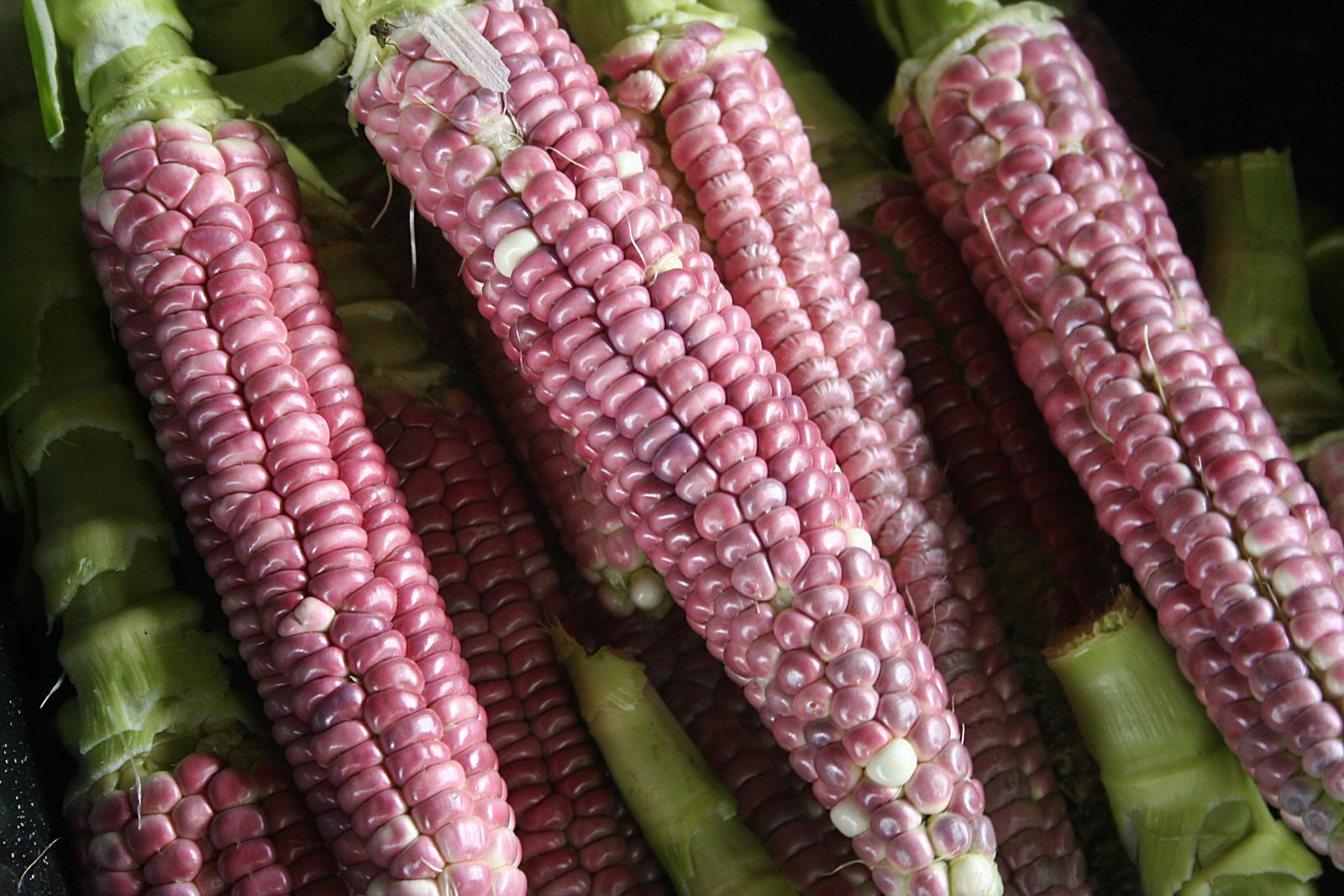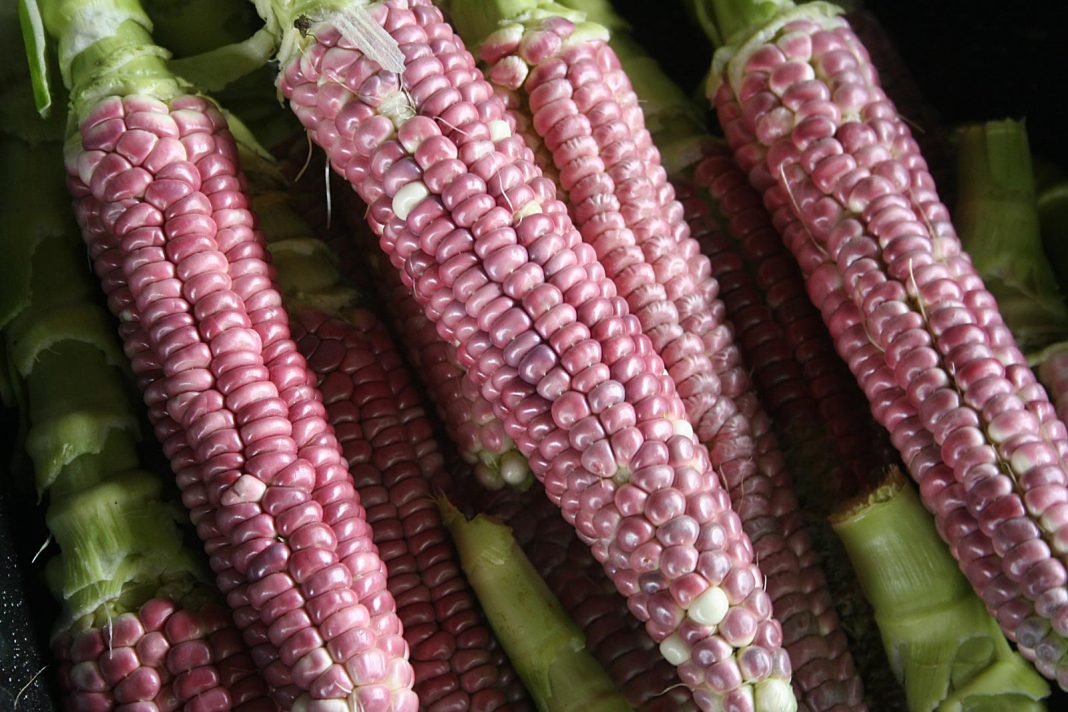As fall approaches, our crops are ripening in earnest. The blackbirds are again attacking our corn crops, most of all, the Mandan Lavender Parching corn. I’m picking the corn as soon as it is past the milk stage, into the dough stage, so it will finish up drying down in the house. What a beautiful (and tasty) corn it is, too! Besides that, it is our earliest corn, already starting to dry on the stalk.

I got all of our friend, Dick’s, sweet corn canned up, all two burlap sacks full. He invited me back for another go-round this week. So far, I’ve got 19 pints and 32 half pints canned up. Boy does that ever feel good! And right now, I have a Mehu Liisa steam juicer full of cut up apples which will give us not only apple juice but also sweet applesauce. Mmmm — no sugar needed here!
Will’s been busy haying as we have had a few rain-free days in a row. Yesterday he cut a big field, working until 8:30 at night as we’re supposed to have two dry days ahead. (Of course, that can change; it seems like the weather forecasts have been really off lately!)
Yesterday I noticed a new Monarch butterfly just drying off on the ground below my Butterfly Weed in the front flower bed. I carefully encouraged him to step onto my finger and I placed him on the foliage so he wouldn’t get stepped on by accident. What a gorgeous “flying flower.” I’m so glad I planted those flowers! They are going to seed now, so I’m going to spread some around the place for even more Monarch food.

Today I went out in the Central garden and picked a bucket full of King of the Early dry beans. The cows had waded through the beans on their way to the corn so the plants were every which way, not in nice rows any more. But I did get the driest ones picked and shelled. What a pretty bean. (As they dry, they do darken some but they’re still gorgeous.) And they’re one of our favorite beans for chili too. Much better than red kidneys, I think.

I’ve also been picking some tomatoes to save for seed as they’re finally coming ripe. Everything seems late this year but that’s okay, I seem late too! Boy, I’ve got some real nice cabbages this year — Late Flat Dutch. I’ll bet some weigh in at 15 pounds each! Lots to make into Amish Coleslaw to can, along with a bunch to slice up and dehydrate. And I can’t wait to have the first freshly cooked either. I like to par-boil it then drain and fry in butter. Serve with hot dinner rolls and yum! — Jackie




Probably a silly canning question but sometimes instructions say to remove the rim after canning and other times it isn’t mentioned. Is there a rule of thumb regarding this?
Wow those beans are almost as pretty as the Monarch!
Maggie
Not a silly question at all. I remove all the rings on my jars after they are cooled. Then I wash the jars with warm soapy water and dry them. The reason I take the rings off is some foods like sweet corn contain sugars or starches which later on dry and form like glue between the rings and the jar, making them VERY hard to remove even with a jar wrench. Another reason is the rings can attract rust and that makes the lids rust much faster than they would if you had removed the rings.
I’m very endeared by your magazine, articles online, and blog. I’ve been a part of other ‘groups’, especially on fb. Something is different in this group. It’s more down-to-earth, homey, friendly. . .homey! I can’t shake it, reading articles and comments. I love it and can’t wait to get the printed magazine, and read my new books by Jackie! I’m getting fond, already! I live on a mountain in northern California. Is Jackie in Philamath, Oregon? Thanks!
I’m glad you like what you see Elizabeth. Welcome to our family! No, I live in northern Minnesota, 0n a 200 acre homestead right in the middle of the woods. Our driveway is a mile and a half long!
Have you ever canned sauerkraut in jars? I’m in that process now & am still waiting for it to stop fermenting so I can process it. I am on day 4.
I’m going to make the Amish recipe you posted too.
I did years ago but just make it in crocks then can it up; less messing around that way.
Do you use a mandolin to shred your vegetables for the slaw, or just a sharp knife?
I can’t wait to make it. It sounds delicious.
I just use a sharp knife. I’ve got an old-time kraut cutter for when I do sauerkraut though for big-time slicing.
Hi Jackie, thanks so much for the Amish coleslaw recipe. I noticed the directions called for water (in the syrup), but the amount was not listed in ingredients. How much water please? And is it safer to use pint jars? Thx!
At what point can one pick beans for drying ? I have tried picking them when they look fully formed but they generally shrivel and look off colored, tried leaving them on the vine until the vine dies in the fall but we often have wetter weather in the fall and they generally tend to mold There has to be a better time but I guess I have yet to find it.
If you wait until the pods get at least somewhat leathery, you can pick them and lay them out on a table to finish drying in the pod, then shell them out. You’ll find some varieties tend to mold quicker than do others. As we have fall rains too, we try to only grow beans we can more easily save seeds from.
You’ll find this familiar=this year I planted your Bear Island Chippewa corn again. Last year I lost it all to the raccoons. So this year I put an electric fence around the perimeter and another specifically around the rows of corn (2 strands-ground level the other 4-6 inches above). I noticed something got a few ears. I read you can wrap the earns with duck tape which I painfully carefully did. They ate all the ears-jheez! Crazy they never touched my 1/3 acre of sweet corn. I’ve learned they love this corn. Busy time here, canning sweet corn, pickles, tomatoes, digging potatoes. I’ll try the cabbage recipe. It was voles eating the tomatoes! Your beans are pretty.
Holy cow, see why I hate raccoons???? They used to get in our sweet corn some years when we grew for market and that was a disaster. I finally foiled them by putting up a 6′ high welded 2″ x 4″ wire fence then using stand-off insulators, I put electric wire 6″ up then another strand at 12″ and another at 18″. What a lot of fussing. But it stopped them!
We are in harvest mode too and other than being tired, I love it!
Sure, Zerilda. Here’s mine:
1 large head of cabbage
1 carrot, peeled
1 lg onion peeled
2 Tbsp canning salt
SYRUP
2 C white vinegar
3 Sugar
1 tsp celery seed
1 tsp mustard seed
Mix vinegar, sugar, water, and spices. Bring to boil and boil for 1 minute and mix to dissolve sugar. Let mixture cool.
Shred cabbage, onion and carrot.
Put veggie mixture in a large bowl and sprinkle with the 2 tablespoons of pickling salt. Then let it set for 1 hour. Then rinse and drain.
Add rinsed and drained cabbage mixture to cooled syrup and toss, making sure you coat all of the cabbage.
Pack cabbage mixture in jars. Ladle syrup over cabbage mixture, use a chopstick by sticking down through to remove air bubbles and distribute liquid then add more liquid if needed leaving 1/2 inch head space.
Process for 15 minutes in a boiling water bath canner.
It looks like I”m going to have to try some of your beans!! The King of the Early dried beans sound really good! I better add that to my list!!!
So how do you can coleslaw? Amish or any kind!!
We are getting some much needed rain today! So happy! thanks for sharing!!
It’s really pickled sweet cabbage so don’t let the “coleslaw” name scare you off. Glad you’re getting some rain!
I love the color of that corn and I might have to order some from you this year. It is now full blown canning time here. It seems after I am done milking and feeding the animals it’s right into canning up until bed time. I have even canned while milking dropping them in the canner. I have done 104 pints of corn along with freezing some. Like the saying goes you have to make hay while the sunshines.
Yes, you do! For maybe next year the cows will eat your corn…..
I have a lot of cabbage to put up also. I’ve made sauerkraut and freezer coleslaw but Amish coleslaw canned sounds like a really good idea. Do you give out your recipe for that? I have always read all of your columns in the Backwoods Home but just recently signed up for your blog. Your articles and blog reaffirm me when I spend hours canning, etc.
It’s above. One mistake I made is to add the word “water” to the directions. There is no water added.
The corn in your picture is a beautiful color . But I have to say that your picture of the butterfly is gorgeous !!
I thought so too!
Hello from the mountains of North Georgia, two hours north of Atlanta. Reading about your homestead makes me try to figure out a way to grow many more vegetables on our one acre on the side of a mountain. It may be hard though because we have discovered we have twin one-year old black bears that visit our house! Every time we grill “Liberty and Justice” come to visit….they peer right into the kitchen door and then turn their backs to us and try to figure out how to get to our veggies and berries. They are so cute and always so clean even in all the rain we’ve had this spring/summer. I tried gardening in pots this year but that was a bust because of the rain, the little bears cubs and the mourning doves who we caught stealing our strawberries and blue berries! My question is if I order seeds from your wonderful catalog would they work well in this zone (7 or 7.5) at 2529 elevation.? Enjoy your harvesting!!
I’ve been looking for that catalog you’ve mentioned. I was unaware until you mentioned it. Thanks! Hope I can find it.
We have a website with all our varieties there, with photos. It’s http://www.seedtreasures.com or e-mail me with your address and I’ll send you a copy of the catalog.
Yes, we have real satisfied customers all over the country and Canada too!
Do you have a recipe for Amish coleslaw to can? That sounds great. I had a cabbage that wighed in at 5 lbs, and I thot that was big, till I heard of yours ! I just got a Bill Bean tomatoe that weighed 2.08 lbs.. and lots more green ones that big. You must do nothing but can and preserve all day long, I am impressed with all you do.
Could you please give details on how to dehydrate cabbage. I really want to give this a try.
It’s really simple. I just core the cabbage and remove any old, damaged leaves. then I quarter it and slice it up like you would for sauerkraut. I fluff it out to lay in a single layer on my dehydrator trays then dehydrate at about 135 degrees until it’s dry. You can easily rehydrate it with boiling water or toss a handful into stews or soups. Very nice!
Comments are closed.